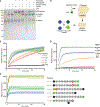Type III-B CRISPR-Cas cascade of proteolytic cleavages
- PMID: 38301007
- PMCID: PMC11220425
- DOI: 10.1126/science.adk0378
Type III-B CRISPR-Cas cascade of proteolytic cleavages
Abstract
The generation of cyclic oligoadenylates and subsequent allosteric activation of proteins that carry sensory domains is a distinctive feature of type III CRISPR-Cas systems. In this work, we characterize a set of associated genes of a type III-B system from Haliangium ochraceum that contains two caspase-like proteases, SAVED-CHAT and PCaspase (prokaryotic caspase), co-opted from a cyclic oligonucleotide-based antiphage signaling system (CBASS). Cyclic tri-adenosine monophosphate (AMP)-induced oligomerization of SAVED-CHAT activates proteolytic activity of the CHAT domains, which specifically cleave and activate PCaspase. Subsequently, activated PCaspase cleaves a multitude of proteins, which results in a strong interference phenotype in vivo in Escherichia coli. Taken together, our findings reveal how a CRISPR-Cas-based detection of a target RNA triggers a cascade of caspase-associated proteolytic activities.
Conflict of interest statement
Figures





References
-
- van Beljouw SPB, Sanders J, Rodríguez-Molina A, Brouns SJJ, RNA-targeting CRISPR–Cas systems. Nat Rev Microbiol 21 (2022). - PubMed
-
- Steens JA, van der Oost J, Staals RHJ, Compact but mighty: Biology and applications of type III-E CRISPR-Cas systems. Mol Cell 82, 4405–4406 (2022). - PubMed
-
- Steens JA, Zhu Y, Taylor DW, Bravo JPK, Prinsen SHP, Schoen CD, Keijser BJF, Ossendrijver M, Hofstra LM, Brouns SJJ, Shinkai A, van der Oost J, Staals RHJ, SCOPE enables type III CRISPR-Cas diagnostics using flexible targeting and stringent CARF ribonuclease activation. Nat Commun 12, 1–12 (2021). - PMC - PubMed
Publication types
MeSH terms
Substances
Supplementary concepts
Grants and funding
LinkOut - more resources
Full Text Sources
Molecular Biology Databases
Research Materials

